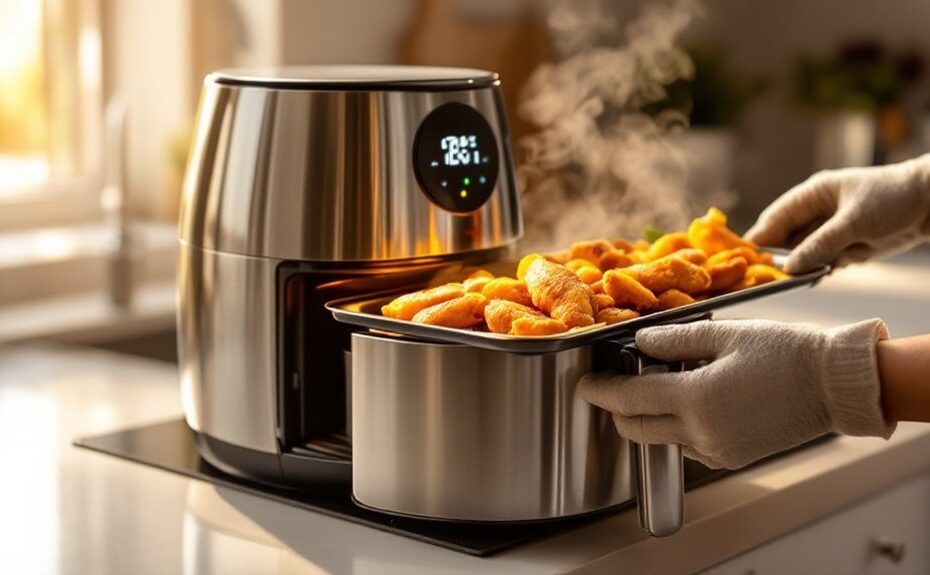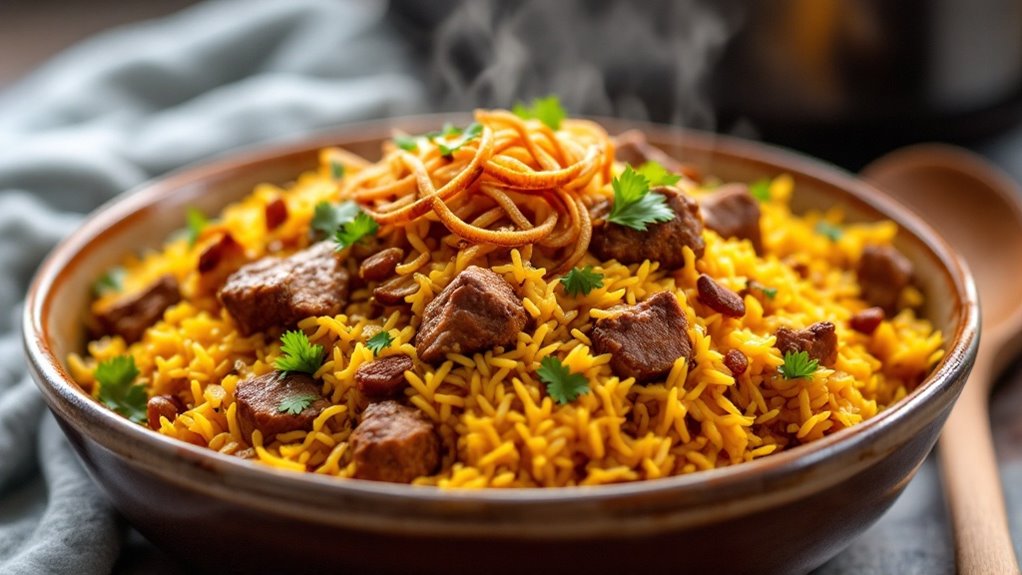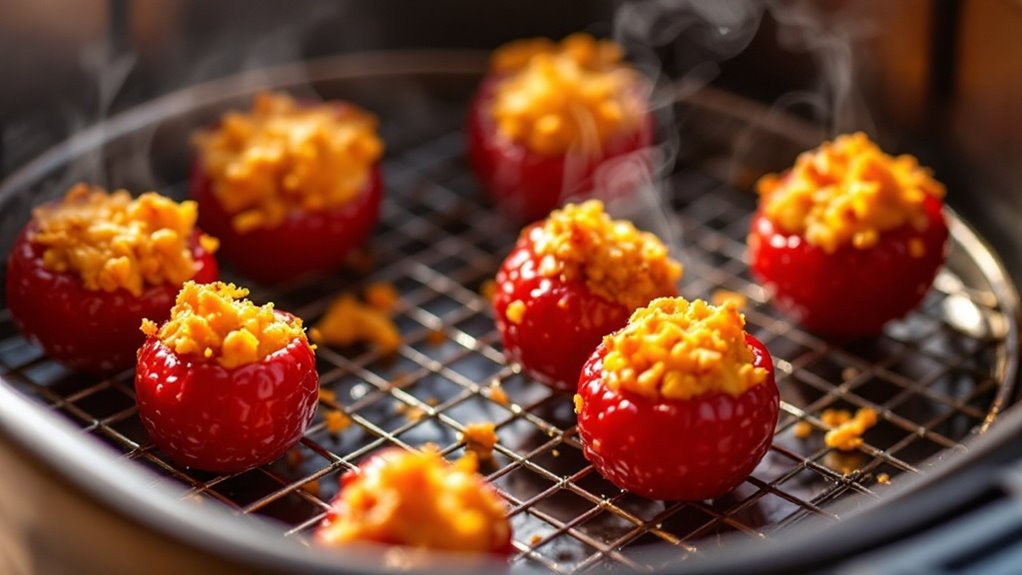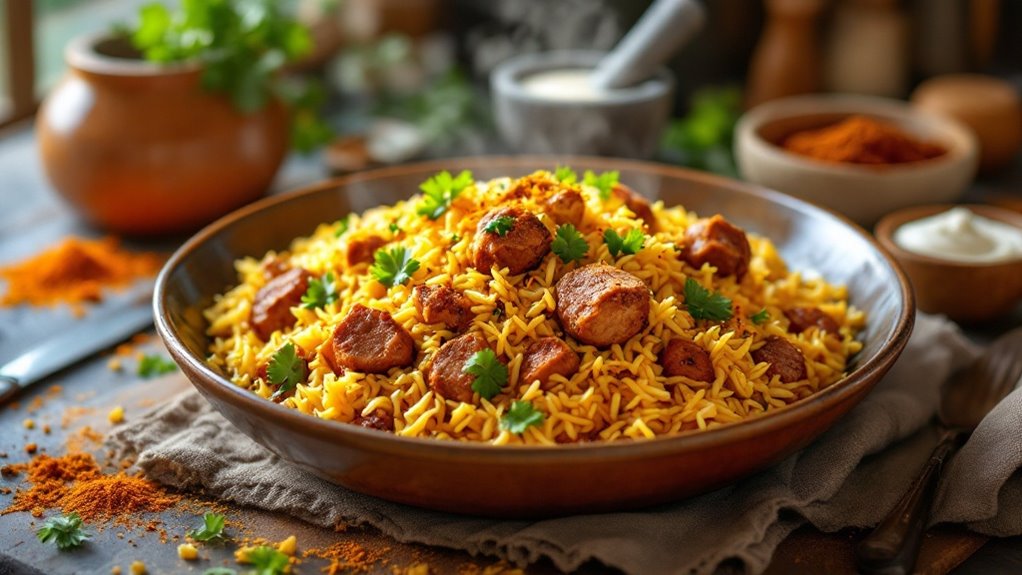Over 40% of households now own an air fryer, but many first-time users aren't sure where to start. You'll need to unbox and inspect your appliance, then clean the basket and accessories before use. Preheating is key, but the temperature and timing depend on what you're cooking. Overcrowding the basket can lead to uneven results, so spacing matters. Once you've mastered the basics, you'll access a world of crispy, healthier meals. But there's a vital step many overlook—something that could make or break your air-frying experience. Ready to find out what it is?
Key Takeaways
- Unbox and inspect the air fryer, ensuring all parts are present and undamaged before use.
- Clean removable parts like the basket and tray with warm, soapy water before first use.
- Preheat the air fryer to 350°F–400°F for 3–5 minutes to ensure optimal cooking performance.
- Arrange food in a single layer, avoiding overcrowding, and shake or flip halfway for even cooking.
- Follow recipe-recommended temperatures and cooking times, adjusting as needed for desired crispiness and doneness.
Unbox and Inspect Your Air Fryer
Before you start cooking, carefully unbox your air fryer and inspect all components to confirm everything is intact. Begin by removing the packaging materials, making sure no small parts are left behind. Check the main unit, basket, crisper tray, and any additional accessories against the included inspection checklist. Look for scratches, dents, or cracks that could affect performance. Verify the heating element and fan are free of obstructions or damage. Make certain the power cord is undamaged and securely attached. Wipe down all removable parts with a damp cloth to remove any manufacturing residue. Keep the original packaging temporarily in case you need to return or exchange the unit. Following these unboxing tips guarantees your air fryer is ready for safe, efficient use.
Read the User Manual Thoroughly
After unboxing your air fryer, take the time to thoroughly read the user manual, as it's your essential guide to mastering the appliance. Start with the manual overview to familiarize yourself with the appliance's components, functions, and settings. Pay close attention to safety precautions, such as proper placement, ventilation requirements, and handling hot surfaces. The manual will outline specific cooking times, temperature ranges, and preheating instructions tailored to your model. It also provides troubleshooting tips and maintenance guidelines to guarantee durability. Understanding these details prevents mishaps and helps you attain peak performance. Keep the manual accessible for quick reference as you experiment with recipes. By investing time in this step, you'll build confidence and avoid common mistakes, setting the stage for successful air frying.
Wash the Basket and Accessories
Since your air fryer basket and accessories are essential for cooking, start by washing them thoroughly before their first use. Remove the basket, tray, and any additional accessories like racks or skewers. Use warm, soapy water and a non-abrasive sponge to scrub away any manufacturing residues or dust. Pay attention to the mesh or perforated areas of the basket to guarantee proper airflow during cooking. Rinse each piece under running water to remove soap suds, then dry them completely with a soft cloth or let them air-dry. Proper basket maintenance and accessory cleaning prevent odors and secure food safety. Avoid using harsh scrubbers or abrasive cleaners, as they can damage nonstick coatings. Cleanliness sets the foundation for efficient, flavorful cooking in your air fryer.
Plug In and Preheat the Air Fryer
Once your air fryer basket and accessories are clean and dry, plug the appliance into a grounded outlet and make sure it's placed on a stable, heat-resistant surface. Check the power cord safety by confirming it's not tangled or near water. Turn the air fryer on and set it to the desired preheat temperature, typically between 350°F and 400°F, depending on your recipe. Most models take 3-5 minutes to preheat, but consult your manual for specific preheat duration tips. Avoid overcrowding the basket during this step to guarantee even heat distribution. Preheating guarantees your food cooks evenly and achieves that crispy texture air fryers are known for. Keep the appliance away from walls or cabinets to allow proper airflow and prevent overheating.
Choose the Right Cooking Temperature
To achieve the best results with your air fryer, selecting the appropriate cooking temperature is essential. Start by consulting your recipe or food packaging for recommended temperature settings. Most air fryers operate between 175°F (80°C) and 400°F (200°C), offering flexibility for various dishes. For crispy fries or golden chicken wings, aim for 375°F (190°C) to 400°F (200°C). Delicate items like fish or vegetables often require lower heat adjustments, around 350°F (175°C). Avoid overcrowding the basket, as it can affect heat distribution. If you're unsure, begin with a moderate temperature and adjust as needed. Remember, higher temperatures cook faster but may risk burning, while lower settings guarantee even cooking. Mastering these heat adjustments guarantees perfectly cooked meals every time.
Set the Timer for Your Recipe
When preparing your dish in the air fryer, setting the timer correctly guarantees your food cooks evenly and avoids over- or undercooking. Start by consulting your recipe for the recommended timing, as air fryers cook faster than traditional ovens. Adjust the timer based on your air fryer's wattage and the food's thickness—thicker cuts may need extra minutes. For timer accuracy, check your food halfway through and shake or flip it to secure even browning. If you're experimenting, begin with shorter intervals and add time as needed to prevent burning. Recipe timing is vital for achieving crispy exteriors and tender interiors. Always monitor the final minutes closely, as air fryers can swiftly shift from golden perfection to overcooked. Proper timing secures consistent, delicious results every time.
Avoid Overcrowding the Basket
Leave space between food items in the basket to allow hot air to circulate evenly, ensuring a crisp exterior and tender interior. Overcrowding traps steam, leading to soggy results and uneven browning. Arrange ingredients in a single layer, working in batches if necessary, for ideal texture and consistent cooking.
Proper Food Spacing
Proper food spacing is essential for achieving even cooking and crispiness in your air fryer. When arranging your ingredients, make sure there's enough room between each piece to allow hot air to circulate freely. Overcrowding the basket traps steam, leading to soggy results. Use spacing tips like arranging food in a single layer, leaving small gaps between items, and shaking the basket halfway through cooking to redistribute pieces. For larger batches, cook in multiple rounds to maintain proper food arrangement. Avoid stacking or overlapping items, as this blocks airflow and creates uneven textures. By prioritizing spacing, you'll maximize the air fryer's efficiency, guaranteeing each bite is perfectly crisp and evenly cooked. Proper spacing transforms your air-fried dishes from mediocre to exceptional.
Even Cooking Results
Achieving even cooking results in your air fryer hinges on avoiding overcrowding the basket. Overloading prevents proper air circulation, leading to uneven browning and undercooked spots. To maintain temperature control, arrange food in a single layer, leaving space between items. For larger batches, cook in smaller portions, shaking or flipping halfway through to guarantee consistent crispness. Use food rotation techniques, such as turning or rearranging pieces, to expose all sides to the hot air. This secures uniform cooking and prevents hot spots. If you're cooking mixed items, group similar-sized pieces together to balance cooking times. By prioritizing proper spacing and rotation, you'll achieve golden, crispy exteriors and tender interiors every time, maximizing your air fryer's efficiency and delivering restaurant-quality results.
Clean the Air Fryer After Use
Unplug your air fryer and let it cool completely before cleaning to avoid burns or damage. Remove the basket, tray, and any other detachable parts, then wash them with warm, soapy water to remove grease and food residue. Wipe down the interior and exterior with a damp cloth, ensuring no moisture enters the heating element or vents.
Unplug and Cool Down
After you've finished cooking, let the air fryer cool completely before handling it. This is one of the most important safety precautions to prevent burns or damage to the appliance. Unplug the air fryer from the power outlet immediately after use, ensuring proper power cord care by gently pulling the plug, not yanking the cord. Avoid wrapping the cord tightly around the unit; instead, loosely coil it to prevent wear and tear. The heating element and basket will remain hot for several minutes, so resist the urge to touch or move them prematurely. Place the air fryer on a heat-resistant surface while it cools to avoid scorching countertops. Once cooled, you can safely proceed with cleaning and storage, ensuring your appliance stays in top condition for future use.
Wash Removable Parts
Once the air fryer has cooled, remove the basket, tray, and any other detachable components. Wash them with warm, soapy water, using a non-abrasive sponge to avoid scratching nonstick surfaces. For stubborn residue, soak the parts briefly before scrubbing. Rinse thoroughly to remove all soap, ensuring no food particles or grease remain. Dry the components completely with a clean towel or let them air-dry upside down for proper drying. Avoid reassembling or storing parts while damp, as moisture can lead to odors or mold. For safe handling, never immerse the main unit in water; instead, wipe it down with a damp cloth. Regular cleaning maintains performance and prevents buildup, ensuring your air fryer stays in top condition for future use.
Disclosure: As an Amazon Associate, I earn from qualifying purchases.



